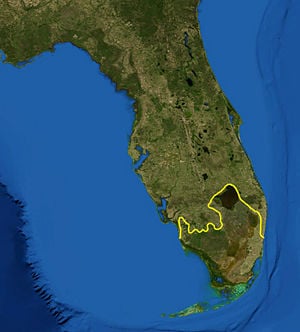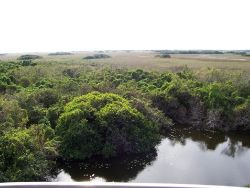Everglades

- Everglades is also the name of a city in Collier County, Florida.
The Florida Everglades are subtropical marshland located in the southern portion of the U.S. state of Florida, specifically in parts of Monroe, Collier, Palm Beach, Miami-Dade, and Broward counties.
Though much modified by agricultural development in central and southern Florida, the Everglades is the southern half of a large watershed arising in the vicinity of Orlando known as the Kissimmee River system. The Kissimmee flows from Taylor Creek, Nubbin Slough, and Fisheating Creek, and discharges into Lake Okeechobee, a very large (730 mi² or 1,890 km²), shallow (10 ft or 3 m) fresh water lake. Water leaving Lake Okeechobee in the wet season forms the Everglades, a shallow, slow-moving flood at one time 40 miles wide and over 100 miles long moving southward across a nearly flat, limestone shelf to Florida Bay at the southern end of the state.
The Everglades extends from Lake Okeechobee on the north to Florida Bay on the south and was once bordered by Big Cypress Swamp on the west and the Atlantic Coastal Ridge on the east. It has been called River of Grass (Douglas, 1947) because of the slow flow of water from Okeechobee southward and the predominance of a sedge known as sawgrass. Slighty elevated points in this extremely flat area are covered with trees, usually cypress and red mangrove.
Some 50 percent of the original Everglades has been lost to agriculture. Most of the rest is now protected in a national park, national wildlife refuge, and water conservation areas. Water from the Everglades is still used as a water supply for major cities in the area, such as Miami. The Everglades is crossed from west to east by a toll road called "Alligator Alley", now part of Interstate 75.
There are several small outlets, such as the Miami River and the New River on the east and the Shark River on the southwest. There is a general south to southwesterly movement of surface water.
Everglades National Park
Everglades National Park preserves the southern portion of the Everglades (all south of Tamiami Trail), but represents only 27.3% of the original area. The Park covers 2.3 million acres (6,593km²) and is a World Heritage Site. The only highway access is the State Road 9336, running 47 miles (73km) from Florida City to the coast at Flamingo. There have been recent expansions to the park's tourist facilities to bring in more money to Florida's economy such as a massive extension to the visiting center, many outposts along the bridges that span the Everglades that teach people about the many birds and other wildlife native to the Everglades as well as a small petting zoo.
For much of its history, systematic exploration of the Everglades was prevented by the dense growth of sawgrass (Cladium jamaicense), a sedge with very sharp saw-toothed leaves. The first European to enter the region was Escalente de Fontenada, a Spanish captive of a Native American chief, who named a lake, Laguno del Espiritu Santo, and some islands, Cayos del Espiritu Santo. Between 1841 and 1856 various United States military forces penetrated the Everglades for the purpose of attacking and driving out the Seminoles, who took refuge here. The most important explorations during the later years of the 19th century were those of Major Archie P. Williams in 1883, James E. Ingraham in 1892, and Hugh L. Willoughby in 1897. The Seminoles were then practically the only inhabitants.
In 1850 under the Arkansas Bill, or Swamp and Overflow Act, practically all of the Everglades, which the state had been urging the federal government to drain and reclaim, were turned over to the state for that purpose, with the provision that all proceeds from such lands be applied to their reclamation. A board of trustees for the Internal Improvement Fund, created in 1855 and having as members ex officio the governor, comptroller, treasurer, attorney-general and commissioner-general, sold and allowed to railway companies much of the grant. Between 1881 and 1896 a private company owning 4,000,000 acres (16,000 km²) of the Everglades attempted to dig a canal from Lake Okeechobee through Lake Hicpochee and along the Caloosahatchee River to the Gulf of Mexico; the canal was closed in 1902 by overflows. Six canals were begun under state control in 1905 from the lake to the Atlantic, the northernmost at Jensen, the southernmost at Ft. Lauderdale; the total cost, estimated at $1,035,000 for the reclamation of 12,500 m², was raised by a drainage tax, not to exceed ten cents per acre ($24.71/km²), levied by the trustees of the Internal Improvement Fund and Board of Drainage commissioners.
The small area reclaimed by prior to that year (1905) was found very fertile and particularly adapted to raising sugar cane, oranges and garden vegetables.
Encroachment
The publication in 1947 of Marjory Stoneman Douglas' Everglades: River of Grass was as electrifying an event among naturalists as Rachel Carson's Silent Spring. It drew attention to the vast area that makes South Florida habitable but was being treated by agricultural interests and housing developers as a worthless swamp that the U.S. Army Corps of Engineers would profitably be able to drain. It galvanized President Harry S. Truman's executive order later that year to protect more than 2 million acres (8,000km²) as Everglades National Park.
The strength of Mrs. Douglas's name was such that when legislation designed by lawyers representing the sugar growers' industry proposed to suspend all water quality standards in the Everglades for twelve years, it was named the Marjory Stoneman Douglas Act—until the 103-year old author demanded that her name be removed from the pending bill. It still passed in 1994, renamed the Everglades Forever Act, and was amended in 2003.
A settlement agreement between the federal government and the State of Florida, and approved by Judge William Hoeveler, imposed a plan to reduce damaging phosphorus levels in the Loxahatchee National Wildlife Refuge and Everglades National Park by December 31, 2006. Additionally, in 2004 the State of Florida adopted a 10 parts per billion numeric criteria for phosphorus within the Everglades Protection Area, which is comprised of the Loxahatchee National Wildlife Refuge, Everglades National Park, and Water Conservation Areas 2 and 3. The excessive phosphorus derives primarily from fertilizer used by sugarcane growers and other agricultural operations as well as construction runoff from the development of coastal areas such as Palm Beach County. Although the vast majority of the Everglades Protection Area currently meets water quality standards, approximately 10% of the area remain severely impacted. The State of Florida and the Army Corps of Engineers are undertaking various projects costing billions of dollars under the Comprehensive Everglades Restoration Plan to help ensure the proper quantity, quality, timing and distribution of waters to the Everglades and all of South Florida. Numerous lawsuits affecting Everglades restoration are pending before the courts.
Non-native/Invasive species

The Everglades also face an ongoing threat from the melaleuca tree (Melaleuca quinquenervia). Sprinkled from airplanes using salt and pepper shakers, the tiny seeds of the thirsty tree were intended to suck up the water and make the "land" of the Everglades suitable for development. The tree remains an invasive nuisance. Additionally, the oils in the trees are highly flammable, which could increase danger from wildfires.
Brazilian Pepper (Florida Holly) has also wreaked havoc on the Everglades, exhibiting a tendency to spread rapidly and crowd out native species. It is especially difficult to eradicate and is readily propagated by birds, which eat its small red berries. The Brazilian Pepper problem is not exclusive to the Everglades; however, neither is the Water Hyacinth, which is a widespread problem in Florida's waterways and a major threat to endemic species, and is also difficult and costly to eradicate.
Native to southern Asia, the Burmese python, Python molurus bivittatus is a relatively new invasive species in the Everglades. This large snake's population growth is due entirely to the indiscriminate pet trade, a growing cause of invasive species in the United States. Florida wildlife officials speculate that local or nearby states' residents have released their pet pythons after discovering that the snake has become too large to keep (record length in captivity: 27 feet). The Everglades habitat is perfect for bivittatus, and this species is said to be reproducing rapidly. There have been at least four recorded encounters between alligators and this large snake. [[1]]
External links
- Water's Journey: Everglades - Comprehensive film and web documentary about the Florida Everglades
- Everglades National Park (National Park Service)
- The Everglades in the Time of Marjorie Stoneman Douglas Photo exhibit created by the State Archives of Florida
- The Comprehensive Everglades Restoration Plan (CERP)
- ACCELER8 (Everglades Restoration)
- 'Judas snakes' plan to remove pythons from the Everglades
- Friends of the Everglades
- Everglades National Park
- Florida Everglades
- Overview of the Everglades' condition on its 50th anniversary, 1997.
- Arthur R. Marshall National Wildlife Refuge (US Fish & Wildlife Service)
- Photos of Everglades National Park - Terra Galleria
- Everglades images at bioimages.vanderbilt.edu (Slow modem version)
- South Florida Environmental Report (South Florida Water Management District and Florida DEP)
- Scientific American Magazine (May 2006) The End of the Everglades? Supreme court case jeopardizes 90 percent of U.S. wetland.
- Official Florida Everglades Tourism Information
- World Wide Fund for Nature - Everglades ecoregion
- World Wide Fund for Nature - South Florida rocklands ecoregion
ReferencesISBN links support NWE through referral fees
- Douglas, Marjory S. 1947. Everglades: River of Grass. (A revised edition was published in 1988 by Pineapple Press, Sarasota, Fl.)
- Lodge, Thomas E. 1994. The Everglades Handbook. Understanding the Ecosystem. CRC Press 228 p. ISBN 1-884015-06-9
- This article incorporates text from the Encyclopædia Britannica Eleventh Edition, a publication now in the public domain.
Rivers: Apalachicola · Caloosahatchee · Kissimmee · Ochlockonee · Peace · St. Johns · Suwannee · Withlacoochee · Yellow
Lakes: Apopka · Blue Cypress · East Toho · George · Harris · Istokpoga · Jackson · Jesup · Kissimmee · Miccosukee · Monroe · Okeechobee · Rodman · Rousseau · Seminole · Talquin · Toho · Tsala Apopka · Washington
Other Rivers: Alafia · Alapaha · Anclote · Aucilla · Blackwater · Chipola · Choctawhatchee · Econfina · Econlockhatchee · Escambia · Hillsborough · Ichetucknee · Little Manatee · Manatee · Miami · Myakka · Ocklawaha · Perdido · Pithlachascotee · Rainbow · St. Lucie · St. Marks · St. Marys · Santa Fe · Shark · Steinhatchee · Tomoka · Trout · Wakulla · Weeki Wachee · Wekiva · Withlacoochee
Canals: Cross Florida Barge Canal · Hillsboro Canal · Miami Canal · Okeechobee Waterway · Tamiami Canal
See Also: Florida Everglades · Intracoastal Waterway · List of Florida rivers
Credits
New World Encyclopedia writers and editors rewrote and completed the Wikipedia article in accordance with New World Encyclopedia standards. This article abides by terms of the Creative Commons CC-by-sa 3.0 License (CC-by-sa), which may be used and disseminated with proper attribution. Credit is due under the terms of this license that can reference both the New World Encyclopedia contributors and the selfless volunteer contributors of the Wikimedia Foundation. To cite this article click here for a list of acceptable citing formats.The history of earlier contributions by wikipedians is accessible to researchers here:
The history of this article since it was imported to New World Encyclopedia:
Note: Some restrictions may apply to use of individual images which are separately licensed.
